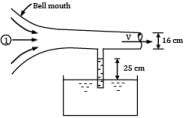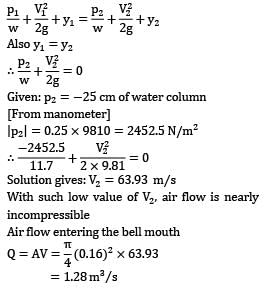Civil Engineering (CE) Exam > Civil Engineering (CE) Questions > An air compressor draws air from the atmosph...
Start Learning for Free
An air compressor draws air from the atmosphere through a bell-mouth entrance calibrated for measuring discharge passing through it in terms of height of water that rises in a single tube manometer installed in the duct which takes air from the bell mouth to the compressor. Determine the flowrate of air through the bell-mouth if the rise of water in the manometer tube is 25 cm and the duct has a diameter of 16 cm. For air density ρ = 1.2 kg⁄m3.
Refer Fig. for the set-up.

Correct answer is 'Range: 1.25 to 1.30'. Can you explain this answer?
Verified Answer
An air compressor draws air from the atmosphere through a bell-mouth ...
Consider the horizontal streamline along the centerline of flow passage with two points shown. Point 1 is a far away point from where the fluid particle starts moving and point 2 is the gauge point in the passage where the manometer is installed.


View all questions of this test

For air, specific weight, w = ρg = 1.2 × 9.81 = 11.77 N/m3.
Applying Bernoulli's equation between point 1 and point 2 Point 1 is the far away point from where the fluid particle starts moving.
∴P1 = 0, V1 = 0

Solution gives: V2 = 63.93 m/s
With such low values of V2 air flow is nearly incompressible
Air flow entering the bell mouth

=1.28 m3/s
Most Upvoted Answer
An air compressor draws air from the atmosphere through a bell-mouth ...
Consider the horizontal streamline along the centerline of flow passage with two points shown. Point 1 is a far away point from where the fluid particle starts moving and point 2 is the gauge point in the passage where the manometer is installed.



For air, specific weight, w = ρg = 1.2 × 9.81 = 11.77 N/m3.
Applying Bernoulli's equation between point 1 and point 2 Point 1 is the far away point from where the fluid particle starts moving.
∴P1 = 0, V1 = 0

Solution gives: V2 = 63.93 m/s
With such low values of V2 air flow is nearly incompressible
Air flow entering the bell mouth

=1.28 m3/s
Free Test
FREE
| Start Free Test |
Community Answer
An air compressor draws air from the atmosphere through a bell-mouth ...
Consider the horizontal streamline along the centerline of flow passage with two points shown. Point 1 is a far away point from where the fluid particle starts moving and point 2 is the gauge point in the passage where the manometer is installed.



For air, specific weight, w = ρg = 1.2 × 9.81 = 11.77 N/m3.
Applying Bernoulli's equation between point 1 and point 2 Point 1 is the far away point from where the fluid particle starts moving.
∴P1 = 0, V1 = 0

Solution gives: V2 = 63.93 m/s
With such low values of V2 air flow is nearly incompressible
Air flow entering the bell mouth

=1.28 m3/s

|
Explore Courses for Civil Engineering (CE) exam
|

|
Question Description
An air compressor draws air from the atmosphere through a bell-mouth entrance calibrated for measuring discharge passing through it in terms of height of water that rises in a single tube manometer installed in the duct which takes air from the bell mouth to the compressor. Determine the flowrate of air through the bell-mouth if the rise of water in the manometer tube is 25 cm and the duct has a diameter of 16 cm. For air density ρ = 1.2 kg⁄m3.Refer Fig. for the set-up.Correct answer is 'Range: 1.25 to 1.30'. Can you explain this answer? for Civil Engineering (CE) 2025 is part of Civil Engineering (CE) preparation. The Question and answers have been prepared according to the Civil Engineering (CE) exam syllabus. Information about An air compressor draws air from the atmosphere through a bell-mouth entrance calibrated for measuring discharge passing through it in terms of height of water that rises in a single tube manometer installed in the duct which takes air from the bell mouth to the compressor. Determine the flowrate of air through the bell-mouth if the rise of water in the manometer tube is 25 cm and the duct has a diameter of 16 cm. For air density ρ = 1.2 kg⁄m3.Refer Fig. for the set-up.Correct answer is 'Range: 1.25 to 1.30'. Can you explain this answer? covers all topics & solutions for Civil Engineering (CE) 2025 Exam. Find important definitions, questions, meanings, examples, exercises and tests below for An air compressor draws air from the atmosphere through a bell-mouth entrance calibrated for measuring discharge passing through it in terms of height of water that rises in a single tube manometer installed in the duct which takes air from the bell mouth to the compressor. Determine the flowrate of air through the bell-mouth if the rise of water in the manometer tube is 25 cm and the duct has a diameter of 16 cm. For air density ρ = 1.2 kg⁄m3.Refer Fig. for the set-up.Correct answer is 'Range: 1.25 to 1.30'. Can you explain this answer?.
An air compressor draws air from the atmosphere through a bell-mouth entrance calibrated for measuring discharge passing through it in terms of height of water that rises in a single tube manometer installed in the duct which takes air from the bell mouth to the compressor. Determine the flowrate of air through the bell-mouth if the rise of water in the manometer tube is 25 cm and the duct has a diameter of 16 cm. For air density ρ = 1.2 kg⁄m3.Refer Fig. for the set-up.Correct answer is 'Range: 1.25 to 1.30'. Can you explain this answer? for Civil Engineering (CE) 2025 is part of Civil Engineering (CE) preparation. The Question and answers have been prepared according to the Civil Engineering (CE) exam syllabus. Information about An air compressor draws air from the atmosphere through a bell-mouth entrance calibrated for measuring discharge passing through it in terms of height of water that rises in a single tube manometer installed in the duct which takes air from the bell mouth to the compressor. Determine the flowrate of air through the bell-mouth if the rise of water in the manometer tube is 25 cm and the duct has a diameter of 16 cm. For air density ρ = 1.2 kg⁄m3.Refer Fig. for the set-up.Correct answer is 'Range: 1.25 to 1.30'. Can you explain this answer? covers all topics & solutions for Civil Engineering (CE) 2025 Exam. Find important definitions, questions, meanings, examples, exercises and tests below for An air compressor draws air from the atmosphere through a bell-mouth entrance calibrated for measuring discharge passing through it in terms of height of water that rises in a single tube manometer installed in the duct which takes air from the bell mouth to the compressor. Determine the flowrate of air through the bell-mouth if the rise of water in the manometer tube is 25 cm and the duct has a diameter of 16 cm. For air density ρ = 1.2 kg⁄m3.Refer Fig. for the set-up.Correct answer is 'Range: 1.25 to 1.30'. Can you explain this answer?.
Solutions for An air compressor draws air from the atmosphere through a bell-mouth entrance calibrated for measuring discharge passing through it in terms of height of water that rises in a single tube manometer installed in the duct which takes air from the bell mouth to the compressor. Determine the flowrate of air through the bell-mouth if the rise of water in the manometer tube is 25 cm and the duct has a diameter of 16 cm. For air density ρ = 1.2 kg⁄m3.Refer Fig. for the set-up.Correct answer is 'Range: 1.25 to 1.30'. Can you explain this answer? in English & in Hindi are available as part of our courses for Civil Engineering (CE).
Download more important topics, notes, lectures and mock test series for Civil Engineering (CE) Exam by signing up for free.
Here you can find the meaning of An air compressor draws air from the atmosphere through a bell-mouth entrance calibrated for measuring discharge passing through it in terms of height of water that rises in a single tube manometer installed in the duct which takes air from the bell mouth to the compressor. Determine the flowrate of air through the bell-mouth if the rise of water in the manometer tube is 25 cm and the duct has a diameter of 16 cm. For air density ρ = 1.2 kg⁄m3.Refer Fig. for the set-up.Correct answer is 'Range: 1.25 to 1.30'. Can you explain this answer? defined & explained in the simplest way possible. Besides giving the explanation of
An air compressor draws air from the atmosphere through a bell-mouth entrance calibrated for measuring discharge passing through it in terms of height of water that rises in a single tube manometer installed in the duct which takes air from the bell mouth to the compressor. Determine the flowrate of air through the bell-mouth if the rise of water in the manometer tube is 25 cm and the duct has a diameter of 16 cm. For air density ρ = 1.2 kg⁄m3.Refer Fig. for the set-up.Correct answer is 'Range: 1.25 to 1.30'. Can you explain this answer?, a detailed solution for An air compressor draws air from the atmosphere through a bell-mouth entrance calibrated for measuring discharge passing through it in terms of height of water that rises in a single tube manometer installed in the duct which takes air from the bell mouth to the compressor. Determine the flowrate of air through the bell-mouth if the rise of water in the manometer tube is 25 cm and the duct has a diameter of 16 cm. For air density ρ = 1.2 kg⁄m3.Refer Fig. for the set-up.Correct answer is 'Range: 1.25 to 1.30'. Can you explain this answer? has been provided alongside types of An air compressor draws air from the atmosphere through a bell-mouth entrance calibrated for measuring discharge passing through it in terms of height of water that rises in a single tube manometer installed in the duct which takes air from the bell mouth to the compressor. Determine the flowrate of air through the bell-mouth if the rise of water in the manometer tube is 25 cm and the duct has a diameter of 16 cm. For air density ρ = 1.2 kg⁄m3.Refer Fig. for the set-up.Correct answer is 'Range: 1.25 to 1.30'. Can you explain this answer? theory, EduRev gives you an
ample number of questions to practice An air compressor draws air from the atmosphere through a bell-mouth entrance calibrated for measuring discharge passing through it in terms of height of water that rises in a single tube manometer installed in the duct which takes air from the bell mouth to the compressor. Determine the flowrate of air through the bell-mouth if the rise of water in the manometer tube is 25 cm and the duct has a diameter of 16 cm. For air density ρ = 1.2 kg⁄m3.Refer Fig. for the set-up.Correct answer is 'Range: 1.25 to 1.30'. Can you explain this answer? tests, examples and also practice Civil Engineering (CE) tests.

|
Explore Courses for Civil Engineering (CE) exam
|

|
Signup for Free!
Signup to see your scores go up within 7 days! Learn & Practice with 1000+ FREE Notes, Videos & Tests.























